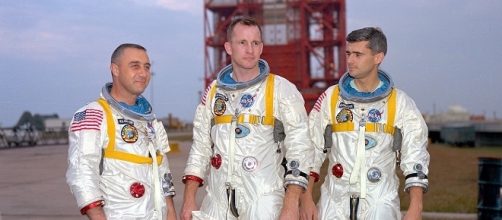According to SpaceRef, the Apollo/Saturn V Center at NASA's Kennedy Space Center in Florida has opened a new exhibit dedicated to the memories of Guss Grissom, Ed White, and Roger Chaffee who died on January 27, 1967 when the Apollo capsule they were in while conducting a test on the launch pad caught fire. Despite the efforts by the pad crew to get them out, the astronauts quickly died of asphyxiation while trapped in the inferno that had swept through the crew cabin.
The cause of the fire was later determined to be an electrical spark that ignited flammable parts of the crew cabin, fed by the pure oxygen atmosphere inside.
The astronauts were unable to get out in time because the hatch could not be opened because of the increased atmospheric pressure inside the spacecraft.
In a larger sense the Apollo Fire was caused by the breakneck speed of the race to the moon and the corner cutting that had resulted. Many of the causes of the fire has been known in advance, but concerns were swept aside in the face of the absolute necessity to get to the moon before the Soviets.
Ironically, the Apollo Fire ensured that America would get to the moon by the end of the 1960s. NASA and contractor engineers were forced to slow down, examine the requirements to build a spacecraft that would be as safe as human possible, and execute the needed redesigns accordingly.
The Apollo spacecraft that carried men to the moon starting in July 1969 was as different from the one that killed Grissom, Wright and Chaffee as any two vehicles could be and still look about the same from the outside.
The exhibit, called "Ad Astra Per Aspera - A Rough Road Leads to the Stars” contains possessions of the astronauts, including clothing, tools, and models. It also includes the very same hatch, scorched by the fire, that proved to be an insurmountable barrier between the the three astronauts and life and safety.
The Apollo fire proved that the price of admiralty, even on the sea of space, is often paid in human lives. It would sadly not be the last time that price would be paid.

